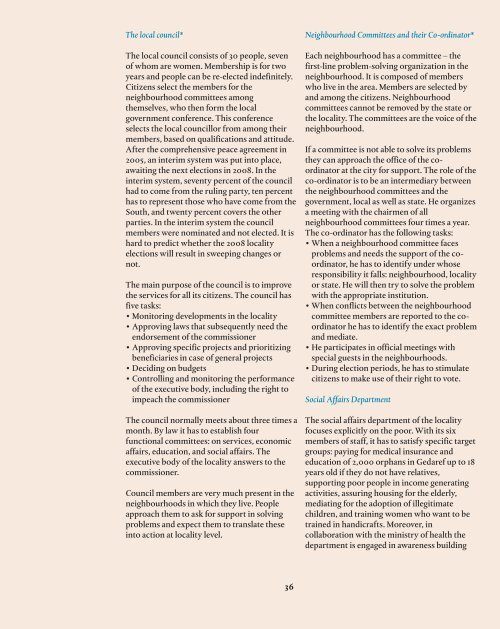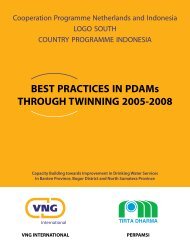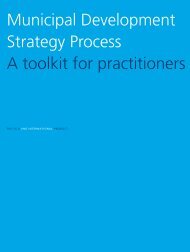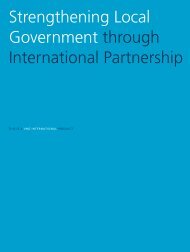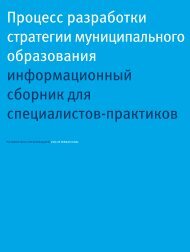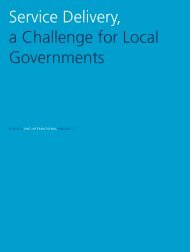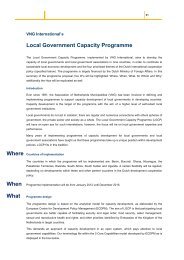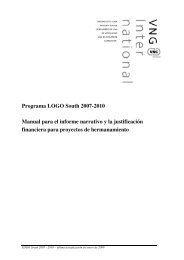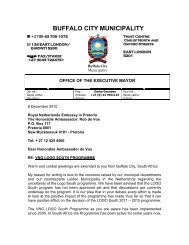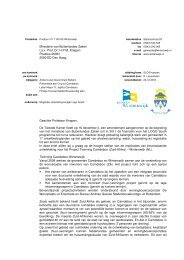Opmaak 1 - VNG International
Opmaak 1 - VNG International
Opmaak 1 - VNG International
You also want an ePaper? Increase the reach of your titles
YUMPU automatically turns print PDFs into web optimized ePapers that Google loves.
The local council*<br />
The local council consists of 30 people, seven<br />
of whom are women. Membership is for two<br />
years and people can be re-elected indefinitely.<br />
Citizens select the members for the<br />
neighbourhood committees among<br />
themselves, who then form the local<br />
government conference. This conference<br />
selects the local councillor from among their<br />
members, based on qualifications and attitude.<br />
After the comprehensive peace agreement in<br />
2005, an interim system was put into place,<br />
awaiting the next elections in 2008. In the<br />
interim system, seventy percent of the council<br />
had to come from the ruling party, ten percent<br />
has to represent those who have come from the<br />
South, and twenty percent covers the other<br />
parties. In the interim system the council<br />
members were nominated and not elected. It is<br />
hard to predict whether the 2008 locality<br />
elections will result in sweeping changes or<br />
not.<br />
The main purpose of the council is to improve<br />
the services for all its citizens. The council has<br />
five tasks:<br />
• Monitoring developments in the locality<br />
• Approving laws that subsequently need the<br />
endorsement of the commissioner<br />
• Approving specific projects and prioritizing<br />
beneficiaries in case of general projects<br />
• Deciding on budgets<br />
• Controlling and monitoring the performance<br />
of the executive body, including the right to<br />
impeach the commissioner<br />
The council normally meets about three times a<br />
month. By law it has to establish four<br />
functional committees: on services, economic<br />
affairs, education, and social affairs. The<br />
executive body of the locality answers to the<br />
commissioner.<br />
Council members are very much present in the<br />
neighbourhoods in which they live. People<br />
approach them to ask for support in solving<br />
problems and expect them to translate these<br />
into action at locality level.<br />
Neighbourhood Committees and their Co-ordinator*<br />
Each neighbourhood has a committee – the<br />
first-line problem-solving organization in the<br />
neighbourhood. It is composed of members<br />
who live in the area. Members are selected by<br />
and among the citizens. Neighbourhood<br />
committees cannot be removed by the state or<br />
the locality. The committees are the voice of the<br />
neighbourhood.<br />
If a committee is not able to solve its problems<br />
they can approach the office of the coordinator<br />
at the city for support. The role of the<br />
co-ordinator is to be an intermediary between<br />
the neighbourhood committees and the<br />
government, local as well as state. He organizes<br />
a meeting with the chairmen of all<br />
neighbourhood committees four times a year.<br />
The co-ordinator has the following tasks:<br />
• When a neighbourhood committee faces<br />
problems and needs the support of the coordinator,<br />
he has to identify under whose<br />
responsibility it falls: neighbourhood, locality<br />
or state. He will then try to solve the problem<br />
with the appropriate institution.<br />
• When conflicts between the neighbourhood<br />
committee members are reported to the coordinator<br />
he has to identify the exact problem<br />
and mediate.<br />
• He participates in official meetings with<br />
special guests in the neighbourhoods.<br />
• During election periods, he has to stimulate<br />
citizens to make use of their right to vote.<br />
Social Affairs Department<br />
The social affairs department of the locality<br />
focuses explicitly on the poor. With its six<br />
members of staff, it has to satisfy specific target<br />
groups: paying for medical insurance and<br />
education of 2,000 orphans in Gedaref up to 18<br />
years old if they do not have relatives,<br />
supporting poor people in income generating<br />
activities, assuring housing for the elderly,<br />
mediating for the adoption of illegitimate<br />
children, and training women who want to be<br />
trained in handicrafts. Moreover, in<br />
collaboration with the ministry of health the<br />
department is engaged in awareness building<br />
36


